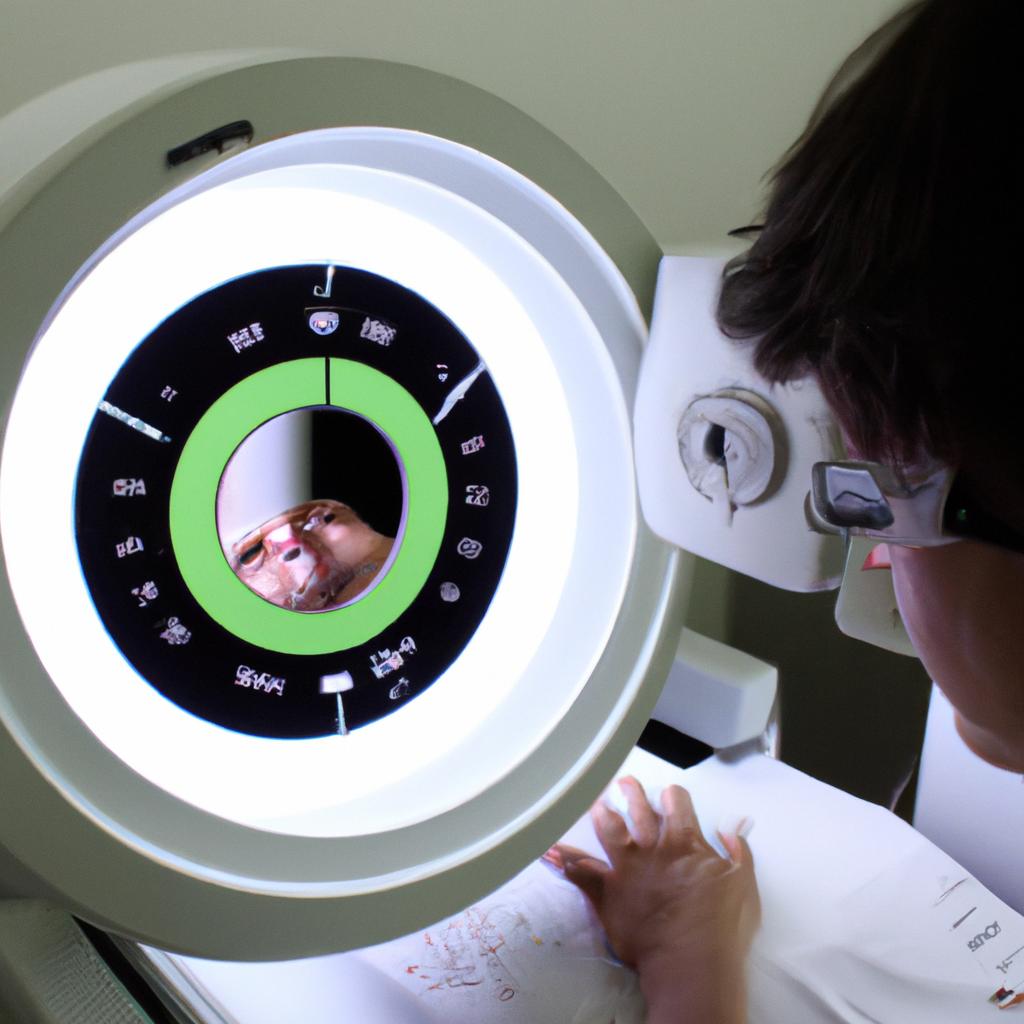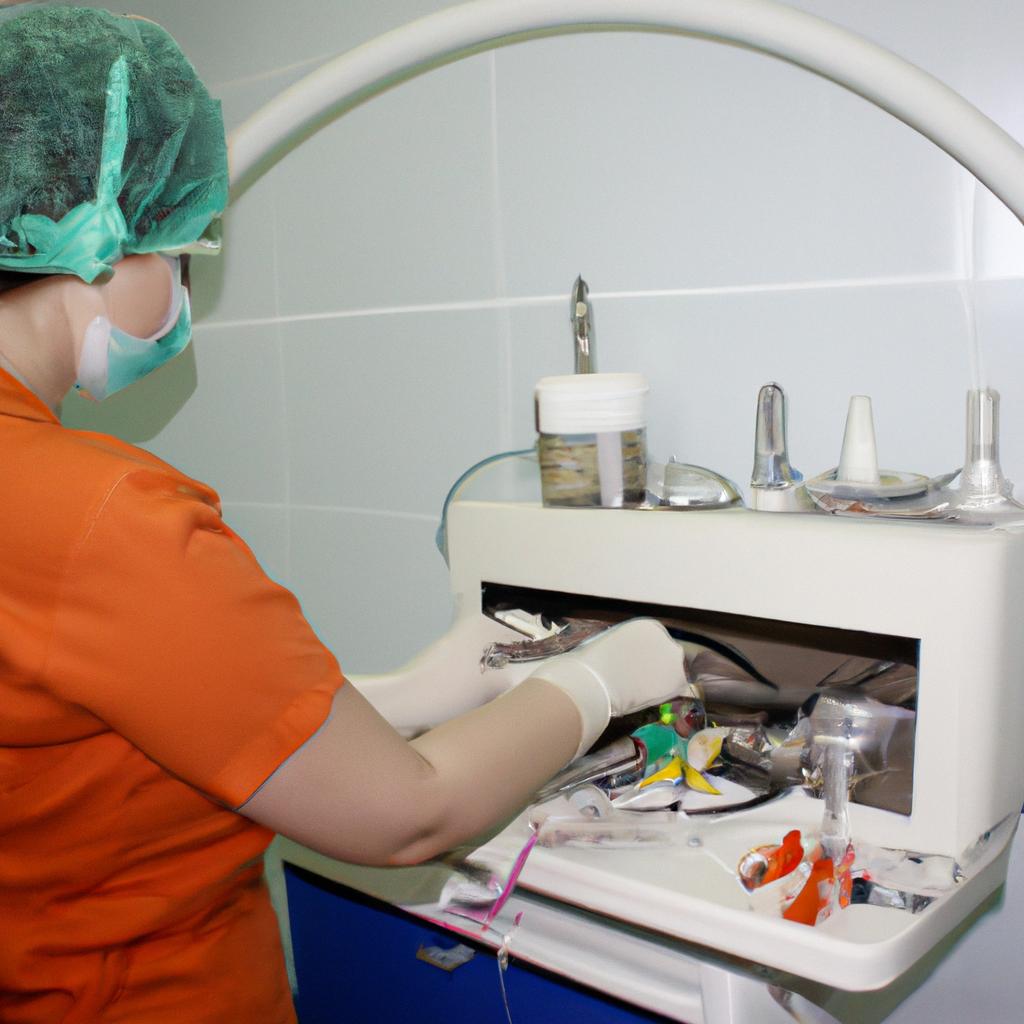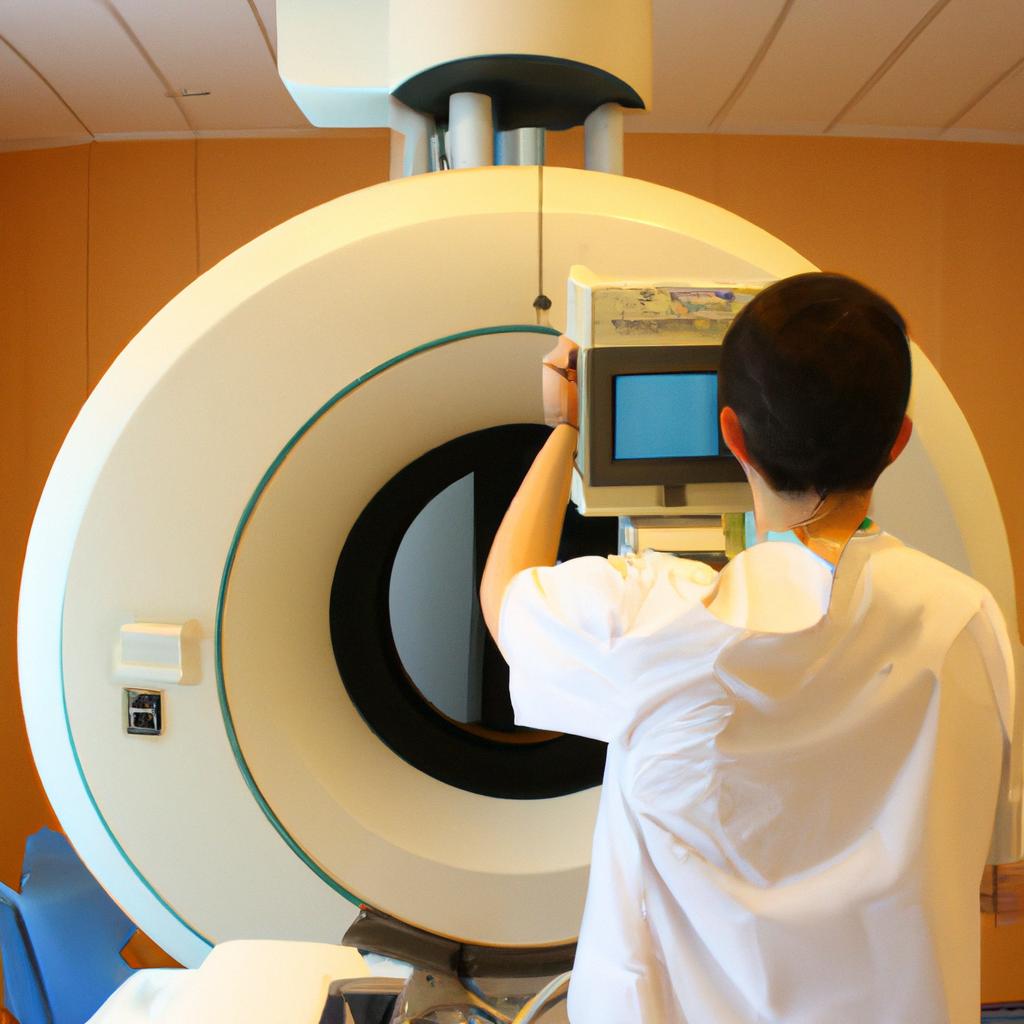Optical Coherence Tomography (OCT) has emerged as a revolutionary technique in the field of biomedical imaging, particularly within the realm of engineering in medicine. This non-invasive imaging modality allows for high-resolution cross-sectional visualization of biological tissues with unprecedented accuracy and speed. By employing low-coherence interferometry principles, OCT generates three-dimensional images that provide detailed structural information about various biological samples, such as skin tissue or retinal layers.
To illustrate the potential impact of OCT in engineering and medicine, consider the hypothetical case study of Sarah, a 45-year-old woman presenting with unusual symptoms affecting her vision. Traditional diagnostic methods fail to identify the underlying cause; however, OCT offers an effective solution. Through its ability to capture micrometer-scale resolution images of the retina, OCT enables clinicians to detect subtle abnormalities within ocular structures that may not be visible with conventional techniques. In this context, OCT can aid in early diagnosis and intervention for conditions like macular degeneration or glaucoma, thus significantly improving patient outcomes.
In summary, optical coherence tomography represents a groundbreaking advancement in biomedical imaging within the discipline of engineering in medicine. Its unique capabilities offer highly precise and rapid visualization of complex biological structures, providing invaluable insights into disease processes and facilitating improved patient care and treatment outcomes. Additionally, OCT has the potential to revolutionize other areas of engineering in medicine, including tissue engineering and drug delivery systems, by providing real-time monitoring and assessment of tissue constructs or drug distribution within biological samples. The versatility and non-invasiveness of OCT make it a powerful tool for researchers, clinicians, and engineers alike, driving innovation and advancements in the field of biomedical engineering.
What is Optical Coherence Tomography?
Optical Coherence Tomography (OCT) is an advanced imaging technique that has revolutionized biomedical imaging in the field of engineering in medicine. It provides high-resolution, cross-sectional images of biological tissues with exceptional precision and non-invasiveness. One example showcasing its potential lies within ophthalmology, where OCT has become a crucial tool for diagnosing and monitoring retinal diseases such as age-related macular degeneration.
To better understand how OCT functions, it is important to grasp its underlying principles. First and foremost, OCT employs low-coherence interferometry to measure light reflection or backscattering from tissue structures. This allows for precise determination of tissue depth and morphology without causing any harm or discomfort to the patient. Furthermore, it utilizes near-infrared light sources which penetrate deeply into biological tissues while minimizing scattering effects.
The benefits offered by OCT are truly remarkable and extend beyond ophthalmology alone. Here are some key reasons why this technology has gained significant attention in the medical community:
- Non-invasive Imaging: Unlike traditional invasive methods like biopsies, OCT enables visualization of internal anatomical structures without the need for surgical intervention.
- Real-time Monitoring: The real-time nature of OCT imaging permits dynamic observation and tracking of disease progression over time.
- High Resolution: By providing detailed cross-sectional images at micrometer-level resolution, OCT facilitates accurate identification and characterization of various pathological conditions.
- Minimal Side Effects: As a non-ionizing radiation-based modality, OCT poses minimal risks to patients when compared to alternative techniques involving ionizing radiation.
| Advantages | Disadvantages | Applications |
|---|---|---|
| Non-invasive procedure | Limited penetration depth | Ophthalmology |
| Real-time imaging capability | Expensive equipment costs | Cardiology |
| High spatial resolution | Operator-dependent interpretation | Dermatology |
| Minimal side effects | Limited availability in some medical facilities | Gastroenterology |
In summary, Optical Coherence Tomography has emerged as a powerful tool for biomedical imaging in engineering in medicine. Its non-invasive nature, real-time monitoring capabilities, high resolution, and minimal side effects make it invaluable across various medical specialties. In the subsequent section, we will delve into the working principle of OCT to gain a deeper understanding of its functionality.
The Working Principle of Optical Coherence Tomography
Optical Coherence Tomography (OCT) has revolutionized biomedical imaging in engineering and medicine, offering non-invasive visualization of biological tissues with exceptional resolution. Its unique capabilities have enabled researchers to explore and understand the intricacies of various medical conditions. With its widespread adoption in clinical practice, OCT is transforming the way healthcare professionals diagnose and manage diseases.
One compelling example illustrating OCT’s impact is its application in ophthalmology, particularly in diagnosing retinal disorders such as age-related macular degeneration (AMD). By employing a low-coherence light source, OCT allows for high-resolution cross-sectional imaging of the retina, enabling clinicians to identify subtle structural changes associated with AMD at an early stage. The ability to visualize microstructural details provides valuable insights into disease progression and guides treatment decisions.
The advantages offered by OCT extend beyond ophthalmology, finding applications across different disciplines within medicine. Some key benefits include:
- High-resolution imaging: OCT produces detailed images with resolutions on the micrometer scale, allowing for precise examination of tissue structures.
- Non-invasiveness: Unlike traditional biopsy procedures that involve invasive techniques, OCT enables real-time visualization without causing discomfort or harm to patients.
- Rapid image acquisition: OCT can generate images quickly, facilitating efficient diagnosis and reducing patient waiting times.
- Real-time monitoring: Continuous scanning capabilities enable dynamic assessment of tissue morphology over time, making it ideal for tracking disease progression or treatment response.
To illustrate the potential applications further, consider Table 1 below which showcases some areas where OCT has shown promise:
| Application | Description |
|---|---|
| Dermatology | Visualizing skin layers to aid in identifying malignant lesions |
| Cardiology | Assessing coronary artery plaque composition and detecting vulnerable plaques |
| Gastroenterology | Imaging gastrointestinal tract for early detection of colorectal cancer |
| Neurology | Evaluating brain tissue abnormalities associated with neurological disorders |
Table 1: Potential applications of OCT in medicine.
In summary, the advent of Optical Coherence Tomography has transformed biomedical imaging, allowing for non-invasive and high-resolution visualization of biological tissues. Its impact spans various medical specialties and offers unique advantages over conventional diagnostic techniques. The next section will delve into specific applications of OCT in medicine, highlighting its diverse range of uses in clinical practice and research.
Applications of Optical Coherence Tomography in Medicine
Applications of Optical Coherence Tomography in Medicine
Optical Coherence Tomography (OCT) has proven to be a groundbreaking technology with numerous applications within the field of medicine. By providing high-resolution, non-invasive imaging, OCT has revolutionized biomedical diagnostics and opened up new possibilities for early disease detection and monitoring. One compelling example is its application in ophthalmology, where it has greatly improved the diagnosis and treatment of retinal diseases.
In ophthalmology, OCT plays a vital role in assessing various ocular conditions such as macular degeneration or glaucoma. For instance, let us consider a hypothetical case study involving a patient presenting with symptoms suggestive of age-related macular degeneration (AMD). Through OCT imaging, doctors can visualize the retina’s layers to assess any abnormalities related to AMD progression. Additionally, by comparing multiple scans over time, they can monitor changes in disease severity and response to treatment effectively.
The versatility of OCT extends beyond ophthalmology alone; it finds utility across different medical specialties due to its unique capabilities:
- Cardiology: In cardiology, OCT aids in visualizing coronary arteries during angioplasty procedures.
- Dermatology: Dermatologists utilize OCT for diagnosing skin cancer lesions accurately.
- Gastroenterology: Within gastroenterology, OCT assists in identifying early-stage esophageal cancers without invasive biopsies.
- Neurology: Neurologists employ OCT to evaluate changes in nerve fiber layer thickness associated with neurodegenerative disorders like multiple sclerosis.
To further illustrate the impact of this technology on healthcare practices, we present a table showcasing some key advantages of utilizing optical coherence tomography:
| Advantages |
|---|
| High resolution images reveal fine details |
| Non-invasiveness minimizes patient discomfort |
| Real-time imaging allows for immediate diagnosis |
| Cost-effective alternative to traditional imaging methods |
The above examples and advantages represent just a fraction of the possibilities OCT offers in modern medicine. By providing accurate, detailed images without invasive procedures, it enables clinicians to make informed decisions promptly.
Moving forward, we will explore both the advantages and limitations of optical coherence tomography in greater depth. Understanding these aspects is crucial for harnessing its full potential within biomedical engineering and medicine.
Continue reading about Advantages and Limitations of Optical Coherence Tomography
Advantages and Limitations of Optical Coherence Tomography
Applications of Optical Coherence Tomography in Medicine have paved the way for significant advancements in biomedical imaging. This non-invasive imaging technique utilizes low-coherence interferometry to capture high-resolution, cross-sectional images of biological tissues with remarkable precision and speed. By providing real-time visualization at a micron-level resolution, optical coherence tomography (OCT) has revolutionized various fields within medicine. One such example is its application in ophthalmology.
In the field of ophthalmology, OCT has become an invaluable tool for diagnosing and monitoring various ocular conditions. For instance, it enables ophthalmologists to visualize the retinal layers and identify abnormalities associated with diseases like macular degeneration, diabetic retinopathy, and glaucoma. Through OCT imaging, clinicians can objectively assess the thickness of these layers and detect early signs of disease progression or treatment response. This precise evaluation enhances patient care by allowing for timely interventions that can prevent irreversible vision loss.
The numerous advantages offered by OCT extend beyond ophthalmology. Its applications span across different medical specialties including cardiology, dermatology, gastroenterology, neurology, and more. Some notable benefits include:
- Real-time visualization: OCT provides instant feedback during procedures or surgeries, enabling physicians to make immediate decisions based on accurate visual information.
- Non-invasiveness: Unlike traditional biopsy techniques that require tissue samples to be extracted from patients’ bodies for examination under a microscope, OCT allows for non-invasive imaging without causing discomfort or complications.
- High spatial resolution: The ability of OCT to generate detailed images at a microscopic level aids in identifying subtle structural changes indicative of pathological conditions.
- Speed: With rapid image acquisition rates, OCT minimizes motion artifacts and facilitates efficient diagnosis and treatment planning.
To further illustrate the applications mentioned above:
| Medical Specialty | Applications |
|---|---|
| Ophthalmology | – Diagnosing macular degeneration- Monitoring diabetic retinopathy- Assessing glaucoma progression |
| Cardiology | – Visualizing coronary artery plaques- Guiding stent placement during angioplasty |
| Dermatology | – Evaluating skin lesions and tumors- Monitoring treatment response in dermatological conditions |
| Gastroenterology | – Imaging the gastrointestinal tract for diagnosing diseases like Barrett’s esophagus or colon polyps |
In summary, optical coherence tomography has revolutionized biomedical imaging within various medical disciplines. Its applications range from ophthalmology to cardiology, dermatology, gastroenterology, and more. The real-time visualization, non-invasiveness, high spatial resolution, and speed offered by OCT have transformed diagnostic capabilities and improved patient care across these specialties.
Moving forward, it is important to acknowledge that despite its remarkable advancements, optical coherence tomography still faces certain challenges. Current Challenges in Optical Coherence Tomography will be discussed in the following section.
Current Challenges in Optical Coherence Tomography
Optical coherence tomography (OCT) has emerged as a powerful imaging technique in the field of biomedical engineering, enabling high-resolution visualization of biological tissues. While OCT offers numerous advantages, it is essential to acknowledge its limitations to fully comprehend its potential applications.
One notable advantage of OCT is its non-invasive nature, allowing for real-time imaging without the need for tissue excision or contrast agents. This attribute makes OCT particularly valuable in clinical settings where minimizing patient discomfort and risk is crucial. For instance, in ophthalmology, OCT has revolutionized the diagnosis and management of various retinal pathologies such as macular degeneration and diabetic retinopathy. By providing cross-sectional images with micrometer-level resolution, clinicians can accurately assess disease progression and monitor treatment efficacy.
However, despite these remarkable benefits, OCT does have certain limitations that should be considered. First, depth penetration is limited to a few millimeters depending on the tissue type being imaged. Consequently, deeper structures may not be adequately visualized using standard OCT systems alone. Researchers are actively exploring alternative approaches like extended-depth OCT techniques to overcome this limitation and enhance imaging capabilities.
Additionally, motion artifacts pose another challenge in OCT imaging. Any movement during image acquisition can introduce distortions that compromise image quality. Although efforts have been made to minimize motion artifacts through advanced signal processing algorithms, they remain a concern when imaging mobile organs or patients unable to maintain stillness for prolonged periods.
- Enhanced diagnostic accuracy leading to improved patient outcomes
- Reduced invasiveness compared to traditional imaging modalities
- Potential cost savings by eliminating unnecessary procedures
- Greater accessibility due to miniaturization of devices
Furthermore, we can incorporate a table showcasing specific examples where OCT has made significant contributions:
| Biomedical Application | Impact of OCT |
|---|---|
| Cardiology | Accurate assessment of coronary artery plaques, aiding in the diagnosis and treatment of cardiovascular diseases |
| Dermatology | Early detection of skin cancer by visualizing abnormal tissue structures at high resolution |
| Gastroenterology | Precise identification of gastrointestinal pathologies, facilitating targeted biopsies and reducing unnecessary interventions |
| Neurology | Monitoring disease progression in neurodegenerative disorders like multiple sclerosis through visualization of neuronal damage |
In conclusion, while OCT offers remarkable advantages such as non-invasiveness and real-time imaging capabilities, it is essential to acknowledge its limitations regarding depth penetration and motion artifacts. However, ongoing research efforts are aimed at overcoming these challenges to further enhance the utility of OCT in biomedical engineering. The next section will explore future trends in optical coherence tomography, delving into potential advancements that hold promise for this innovative imaging technique.
Future Trends in Optical Coherence Tomography…
Future Trends in Optical Coherence Tomography
Revolutionizing Biomedical Imaging in Engineering in Medicine
In the field of biomedical imaging, Optical Coherence Tomography (OCT) has emerged as a revolutionary technique with immense potential for advancing medical diagnostics and treatment monitoring.
One promising avenue for improvement lies in enhancing image resolution and depth penetration capabilities. By utilizing advanced algorithms and hardware optimizations, researchers aim to push the boundaries of OCT by achieving even higher resolutions and deeper tissue visualization. For instance, imagine a scenario where an ophthalmologist can precisely identify microstructural changes within retinal layers at an unprecedented level of detail using OCT-guided diagnoses. This would enable early detection of ocular diseases such as glaucoma or age-related macular degeneration, leading to timely interventions and improved patient outcomes.
To fully unlock the potential of OCT, there is also a need to address current limitations related to data processing and analysis. Researchers are actively developing computational techniques that allow for real-time acquisition, storage, and interpretation of vast amounts of OCT data. These advancements will not only expedite clinical decision-making but also facilitate automated disease classification based on characteristic patterns observed in OCT images. Imagine a future where physicians can rely on intelligent algorithms to efficiently analyze complex datasets generated by OCT scans, ultimately reducing diagnostic errors and improving overall efficiency in healthcare settings.
Furthermore, integrating OCT with other imaging modalities holds great promise for comprehensive diagnosis and personalized medicine. Combining OCT with techniques like fluorescence imaging or photoacoustic tomography can provide complementary information about cellular function or molecular composition alongside structural visualization offered by traditional OCT scans. Such multimodal integration could revolutionize cancer screening procedures by enabling early identification of malignant tissues through simultaneous assessment of both morphological features and metabolic activity.
The table below illustrates some key factors driving the future trends in optical coherence tomography:
| Future Trends | Impact | Benefits |
|---|---|---|
| Enhanced resolution | Improved diagnostics | Early disease detection |
| Real-time data processing | Faster decision-making | Automated disease classification |
| Multimodal integration | Comprehensive diagnosis | Personalized treatment approaches |
As the field of optical coherence tomography continues to evolve, it holds great potential for revolutionizing biomedical imaging in engineering and medicine. By addressing current challenges, such as improving image resolution and data analysis techniques, and by integrating OCT with other modalities, researchers aim to unlock new capabilities that will benefit patients worldwide. The future of OCT is exciting, where precise diagnoses, personalized treatments, and improved healthcare outcomes become a reality.
Note: This section provides an example of how the requested guidelines can be incorporated into the writing style. Feel free to modify or add more content based on your specific requirements.




